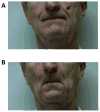A diagnostic model for impending death in cancer patients: Preliminary report
- PMID: 26218612
- PMCID: PMC4618185
- DOI: 10.1002/cncr.29602
A diagnostic model for impending death in cancer patients: Preliminary report
Abstract
Background: Several highly specific bedside physical signs associated with impending death within 3 days for patients with advanced cancer were recently identified. A diagnostic model for impending death based on these physical signs was developed and assessed.
Methods: Sixty-two physical signs were systematically documented every 12 hours from admission to death or discharge for 357 patients with advanced cancer who were admitted to acute palliative care units (APCUs) at 2 tertiary care cancer centers. Recursive partitioning analysis was used to develop a prediction model for impending death within 3 days with admission data. The model was validated with 5 iterations of 10-fold cross-validation, and the model was also applied to APCU days 2 to 6.
Results: For the 322 of 357 patients (90%) with complete data for all signs, the 3-day mortality rate was 24% on admission. The final model was based on 2 variables (Palliative Performance Scale [PPS] and drooping of nasolabial folds) and had 4 terminal leaves: PPS score ≤ 20% and drooping of nasolabial folds present, PPS score ≤ 20% and drooping of nasolabial folds absent, PPS score of 30% to 60%, and PPS score ≥ 70%. The 3-day mortality rates were 94%, 42%, 16%, and 3%, respectively. The diagnostic accuracy was 81% for the original tree, 80% for cross-validation, and 79% to 84% for subsequent APCU days.
Conclusions: Based on 2 objective bedside physical signs, a diagnostic model was developed for impending death within 3 days. This model was applicable to both APCU admission and subsequent days. Upon further external validation, this model may help clinicians to formulate the diagnosis of impending death.
Keywords: death; diagnosis; mortality; neoplasms; palliative care; physical examination.
© 2015 American Cancer Society.
Conflict of interest statement
Figures



References
-
- Hui D, Con A, Christie G, et al. Goals of care and end-of-life decision making for hospitalized patients at a canadian tertiary care cancer center. J Pain Symptom Manage. 2009;38:871–81. - PubMed
-
- Hwang IC, Ahn HY, Park SM, et al. Clinical changes in terminally ill cancer patients and death within 48 h: when should we refer patients to a separate room? Support Care Cancer. 2012;21:835–40. - PubMed
Publication types
MeSH terms
Grants and funding
LinkOut - more resources
Full Text Sources
Other Literature Sources
Medical

